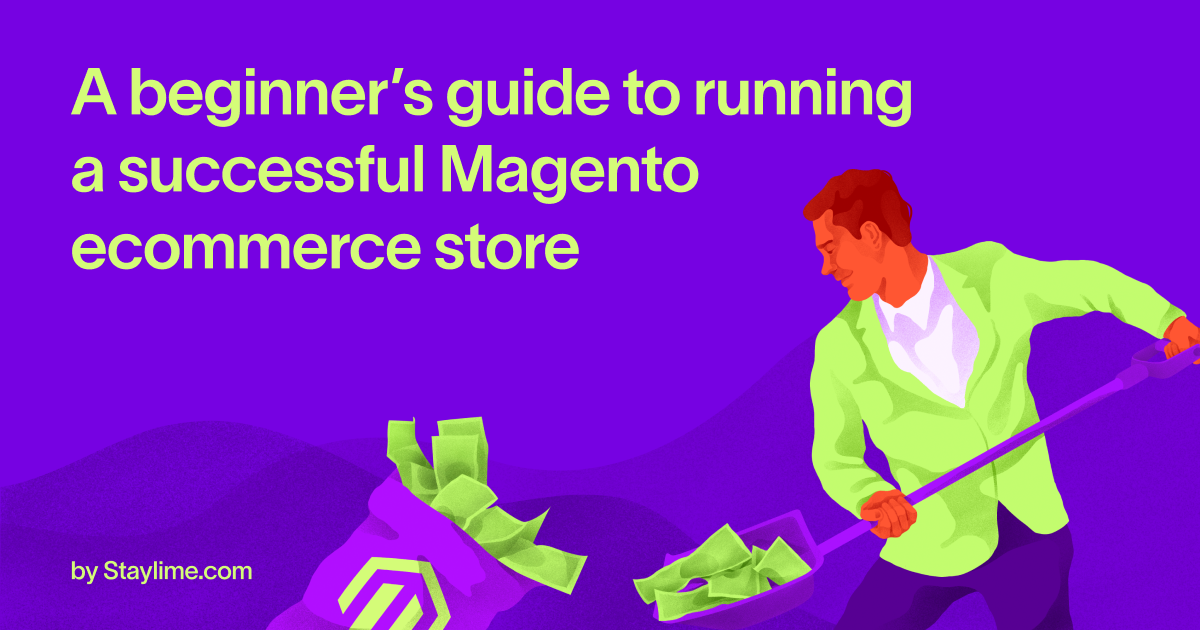Magento e-commerce store
Magento is one of the most feature-rich open-source ecommerce platforms on the market today. Leading global enterprises such as The Coca-Cola Company and Jaguar Land Rover use it to power their online operations because Magento offers industry-leading functionality without a hefty price tag.
But running a Magento ecommerce store without any prior experience can be challenging. With so much functionality at your disposal, managing a website as a small business owner can become overwhelming.
You don’t have to be a Magento developer to run a successful Magento store. This article details how you can leverage the Magento ecommerce platform to build a successful online enterprise.
Table of Contents
Best practices for running a successful Magento ecommerce store
Magento offers tons of user-friendly ecommerce functionality. Here are some pointers that you can implement to help your online business succeed.
Choose the right hosting environment
Magento requires a stable hosting environment to perform optimally and deliver a fast-loading website. A significant factor contributing to poor performance in Magento ecommerce stores is an incorrectly configured hosting environment.
Here are the four primary aspects you must consider when hosting a Magento website:
- CPU,
- Memory,
- Storage,
- Bandwidth.
Magento is used to run high-performance stores serving dynamic content and it relies on several technologies such as Varnish, Redis, and Elasticsearch. Therefore, it requires a lot of memory and computing power.
Ensure that you’re providing your Magento store with sufficient resources according to Adobe’s recommendations. Suppose you’re using a shared hosting provider for your website. In that case, consider migrating to a Dedicated Magento Hosting.
If you need help migrating your Magento store or switching a hosting provider, you can request a quote here.
Prioritize user-friendliness
A user-friendly shopping experience is crucial to maintain healthy conversion and customer retention rates. An attractive website alone isn’t enough to achieve this.
Your website design needs to be clean, consistent, and convenient.
Magento offers a mobile-friendly theme out of the box. But if you want your website to stand out, you need a unique and professional design.
You can consider purchasing a ready-to-use theme to help you get off the ground quickly when you’re bootstrapping your Magento ecommerce store.
However, if you want to create a unique and user-friendly shopping experience for your audience, you will need a custom-made theme for your website.
Seek a Magento development agency with a track record of creating attractive Magento websites.
And if you want to create a seamless and futuristic shopping experience, you can also consider building a Progressive Web Application (PWA) for your Magento store.
Localize your website to its audience
Magento allows you to operate multiple stores and store views using different attributes and content like:
- Separate domain names.
- Default languages,
- Unique categories and products,
- Multiple currencies.
You can configure and administer multiple stores from a single Magento admin panel and offer tailored content to customers from different locations. You can even share catalogs between stores or create separate catalogs for different websites.
For example, if you sell globally, you can create different stores for each of your top-selling countries and personalize the design, content, and promotions for your audience to match their location.
This will help you provide an exclusive shopping experience that fosters loyalty.
Leverage Magento’s powerful promotions
Magento allows you to create and offer complex promotions and discounts on your website using a set of price rules and conditions. You can choose to trigger discounts at the cart level during checkout or at the catalog level to drive conversions and boost sales.
You can use Magento’s price rules to offer incentives such as:
- Free shipping over certain order values,
- Schedule limited-time promotions,
- Generate and issue discount coupons.
For example, if you sell your products to both wholesale and retail businesses, you can create separate customer groups in Magento and offer sitewide discounted pricing to your wholesale customers.
Offer multiple payment options
Imagine this: you’ve finally found the product you want to buy at an unbelievable price. You quickly add it to your shopping cart and proceed to checkout, eagerly entering your shipping information only to learn that the website doesn’t offer your preferred payment method. Disappointing, isn’t it?
According to a quantitative study by Baymard Institute, a lack of payment options is one of the top reasons why customers abandon checkout. Fortunately, Magento supports several online and offline payment methods, including PayPal, Braintree, Amazon Pay, cash on delivery, and bank transfer out of the box.
It also allows you to integrate your store with popular payment processors such as Stripe and 2Checkout using extensions from the Magento marketplace. Make sure you leverage Magento’s extensibility and offer your customers a healthy mix of online and offline payment options so you can:
- Increase conversions,
- Decrease cart abandonment,
- Boost customer satisfaction,
- Increase customer retention.
Simplify the checkout process
Piggybacking off the last tip, in addition to offering multiple payment options, make sure you simplify checkout using Magento’s Onepage Checkout feature. It will help reduce the number of steps in checkout, allowing your customers to place orders quickly.
Additionally, you could enable guest checkouts to allow new customers to place orders without having an account on your website. You can always offer an option to create an account after they’ve placed their order.
Another important step in simplifying the checkout process is to display simple product images in the shopping cart. Magento displays the parent product image as the product thumbnail in the shopping cart by default. This can create confusion, leading customers to click back during the final stages of the checkout.
You can change this default setting by navigating to Stores > Settings > Configuration > Sales > Checkout. Expand the “Shopping Cart” section, update the values of “Grouped Product Image” and “Configurable Product Image” to “Product Thumbnail Itself,” and click “Save Config.”
Analyze store performance and customer behavior
Magento offers versatile and detailed reporting functionality that provides insights into store performance. It also allows you to export the reports as CSV and Excel files for easier offline collaborations.
The Magento reports section consists of the following subsections:
- Marketing,
- Reviews,
- Sales,
- Customers,
- Products,
- Business Intelligence,
- Customer Engagement.
You can gain granular insights into every aspect of your online store performance, including what your customers are searching for, which products they have in their carts, and which ones are currently trending on your store.
Magento users also enjoy complimentary access to Magento Business Intelligence for deeper analysis and greater insights. We strongly recommend leveraging this feature so that you can fine-tune your business offerings to boost conversions.
Use blogs to drive traffic
Blogs are the backbone of a successful SEO strategy. They can help you drive traffic, generate leads, and increase conversions by providing value to your customers.
In fact, according to Demand Metric, companies that blog regularly generate 67% more leads than companies that don’t. Although Magento doesn’t offer blogging functionality out of the box, you can use third-party extensions to add blogging functionality to your website.
Once you’ve incorporated a blog into your store, start promoting it across your social media profiles and share your content with influencers in your industry. An organized content strategy combined with steady link building will help you drive traffic to your website and build your website authority on Google.
Streamline your operations
Streamlining your business operations can drastically increase efficiency across your business departments. Even if you don’t need a dedicated ERP system for your business, you can benefit from integrating different aspects such as inventory and accounting with your ecommerce store.
Simple yet time-consuming tasks like manually updating order statuses or entering tracking information are prone to human error. You can leverage Magento’s support for popular API technologies like GraphQL and REST to create integrations with most modern systems.
Magento integrations require a deep understanding of the platform and its associated technologies. Therefore, it might be wise to seek Magento services to help you integrate your store with your organizational systems.
Prioritize security
When you’re processing sensitive customer and payment information through your website, you must prioritize the security of your store. Magento offers several in-built security features such as two-factor authentication (2FA), strict content security policies, and session validation.
Make sure all admin users have 2FA enabled. You can do this by navigating to Stores > Settings > Configuration > Security > 2FA and selecting your preferred methods from the “Providers to use” dropdown in the “General” section.
You can enable the built-in Google reCAPTCHA feature to block bots from creating customer accounts and spamming your website with fake orders, product reviews, or comments. Alternatively, you can also use basic CAPTCHA for your website by enabling it in Stores > Settings > Configuration > Advanced > Admin > CAPTCHA.
The bottom line
Magento gives you, the merchant, all the power and flexibility you need to run your business. It incorporates some of the best open-source technologies to deliver a feature-rich and stable ecommerce platform that you can rely on for decades.
Building a successful Magento ecommerce store isn’t complicated. We’ve listed ten simple ways in which you can improve your store performance, boost conversions, and build a successful online business.
Start incorporating these best practices into your daily operations and unlock your ecommerce business growth through Magento.
Author: Jan Guardian

Jan is the Chief Business Development Officer at Staylime, a Magento design and development company headquartered in Redwood City, California. He is a Member of the Magento Association and an Adobe Sales Accredited Magento Commerce professional. Jan is responsible for developing and leading the sales and digital marketing strategies of the company. He is passionate about ecommerce and Magento in particular — throughout the years his articles have been featured on Retail Dive, Hacker Noon, Chief Marketer, Mobile Marketer, TMCnet, and many others.
Linkedin: https://www.linkedin.com/in/janguardian/
Twitter: https://twitter.com/Jan_Guardian

